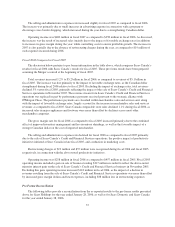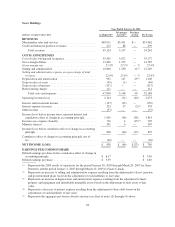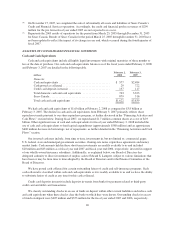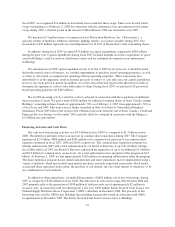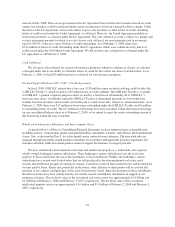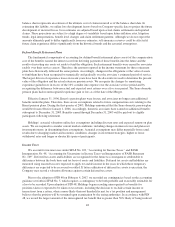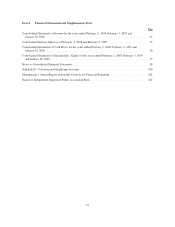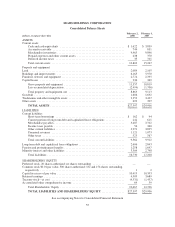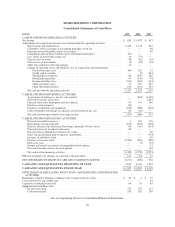Sears 2007 Annual Report Download - page 47
Download and view the complete annual report
Please find page 47 of the 2007 Sears annual report below. You can navigate through the pages in the report by either clicking on the pages listed below, or by using the keyword search tool below to find specific information within the annual report.Management believes the current assumptions and other considerations used to estimate amounts reflected
in the financial statements are appropriate. However, if actual experience differs from the assumptions and the
considerations used in estimating amounts, the resulting changes could have a material adverse effect on our
consolidated results of operations, and in certain situations, could have a material adverse effect on our financial
condition.
Management has discussed the development and selection of these critical accounting estimates with the
Audit Committee of our Board of Directors and the Audit Committee has reviewed the disclosure presented
below relating to the selection of these estimates.
The following is a summary of our most critical policies and estimates. See Note 1 of Notes to Consolidated
Financial Statements for a listing of our other significant accounting policies.
Valuation of Inventory
Our inventory is valued at the lower of cost or market determined primarily using the retail inventory
method (“RIM”). RIM is an averaging method that is widely used in the retail industry. To determine inventory
cost under RIM, inventory at its retail selling value is segregated into groupings of merchandise having similar
characteristics, which are then converted to a cost basis by applying specific average cost factors for each
grouping of merchandise. Cost factors represent the average cost-to-retail ratio for each merchandise group based
upon the fiscal year purchasing activity for each store location. Accordingly, a significant assumption under the
retail method is that inventory in each group is similar in terms of its cost-to-retail relationship and has similar
turnover rates. Management monitors the content of merchandise in these groupings to prevent distortions that
would have a material effect on inventory valuation.
RIM inherently requires management judgment and certain estimates that may significantly affect the
ending inventory valuation as well as gross margin. Among others, two significant estimates used in inventory
valuation are the level and timing of permanent markdowns (clearance markdowns used to clear unproductive or
slow-moving inventory) and shrinkage. Amounts are charged to cost of sales, buying and occupancy at the time
the retail value of inventory is reduced through the use of permanent markdowns.
Factors considered in the determination of permanent markdowns include current and anticipated demand,
customer preferences, age of the merchandise, fashion trends and weather conditions. In addition, inventory is
also evaluated against corporate pre-determined historical markdown cadences. When a decision is made to
permanently markdown merchandise, the resulting gross margin reduction is recognized in the period the
markdown is recorded. The timing of the decision, particularly surrounding the balance sheet date, can have a
significant effect on the results of operations.
Shrinkage is estimated as a percentage of sales for the period from the date of the last physical inventory to
the end of the fiscal year. Physical inventories are taken at least annually for all stores on a staggered basis
throughout the year and inventory records are adjusted accordingly. The shrinkage rate from the most recent
physical inventory, in combination with historical experience, is used as the standard for the shrinkage accrual
following the physical inventory.
Self Insurance Reserves
We use a combination of third-party insurance and/or self-insurance for a number of risks including
workers’ compensation, asbestos and environmental, automobile, warranty, product and general liability claims.
General liability costs relate primarily to litigation that arises from store operations. Self-insurance reserves
include actuarial estimates of both claims filed and carried at their expected ultimate settlement value and claims
incurred but not yet reported. Our estimated claim amounts are discounted using a rate with a duration that
approximates the duration of our self-insurance reserve portfolio. Our liability reflected on the consolidated
47


